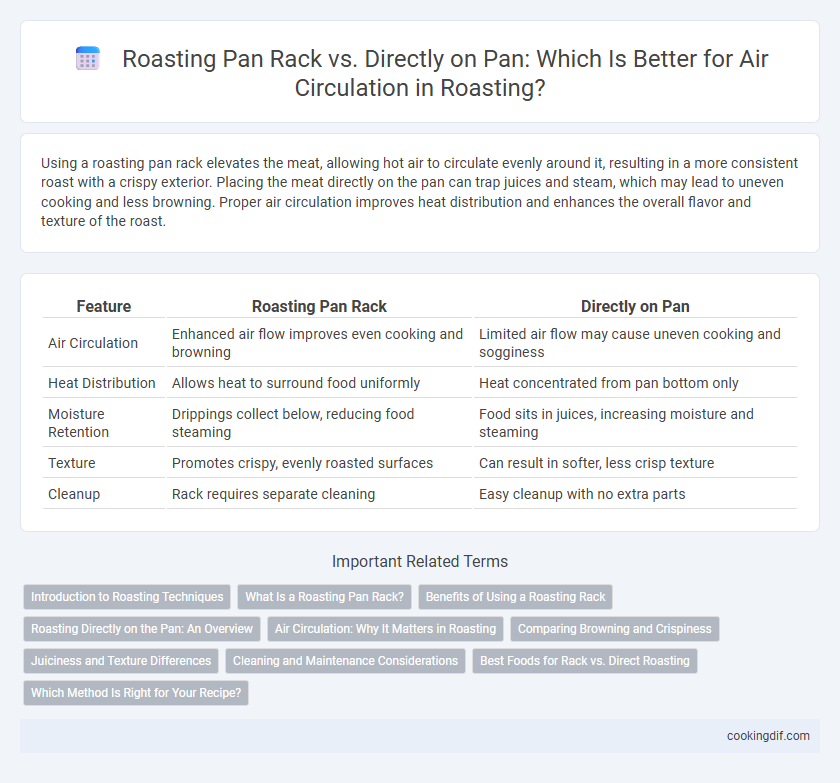Using a roasting pan rack elevates the meat, allowing hot air to circulate evenly around it, resulting in a more consistent roast with a crispy exterior. Placing the meat directly on the pan can trap juices and steam, which may lead to uneven cooking and less browning. Proper air circulation improves heat distribution and enhances the overall flavor and texture of the roast.
Table of Comparison
| Feature | Roasting Pan Rack | Directly on Pan |
|---|---|---|
| Air Circulation | Enhanced air flow improves even cooking and browning | Limited air flow may cause uneven cooking and sogginess |
| Heat Distribution | Allows heat to surround food uniformly | Heat concentrated from pan bottom only |
| Moisture Retention | Drippings collect below, reducing food steaming | Food sits in juices, increasing moisture and steaming |
| Texture | Promotes crispy, evenly roasted surfaces | Can result in softer, less crisp texture |
| Cleanup | Rack requires separate cleaning | Easy cleanup with no extra parts |
Introduction to Roasting Techniques
Roasting pan racks elevate the meat, allowing hot air to circulate evenly around the food, which promotes uniform cooking and browning. Placing the roast directly on the pan can lead to uneven heat distribution and cause the bottom to steam rather than crisp. Proper air circulation in roasting techniques is essential for achieving a flavorful, golden crust while retaining juicy interior textures.
What Is a Roasting Pan Rack?
A roasting pan rack is a metal frame designed to sit inside a roasting pan, elevating meat to allow hot air to circulate evenly around the food. This elevation prevents the meat from sitting in its own juices, promoting better browning and crisping on all sides. Using a roasting pan rack improves heat distribution, resulting in a juicier, more evenly cooked roast compared to placing meat directly on the pan.
Benefits of Using a Roasting Rack
Using a roasting rack elevates meat above the pan, promoting better air circulation and even heat distribution for consistent cooking. This method prevents the meat from sitting in its juices, which enhances browning and creates a crispier, more flavorful crust. Improved airflow also reduces the risk of steaming, resulting in a superior texture compared to placing meat directly in the roasting pan.
Roasting Directly on the Pan: An Overview
Roasting directly on the pan allows juices to caramelize, enhancing flavor and creating natural pan drippings for sauces. Without a rack, the meat's surface contacts the pan, promoting even browning and a crisp crust through direct heat exposure. However, air circulation beneath the roast is reduced, which may affect uniform cooking and requires careful temperature control to avoid steaming.
Air Circulation: Why It Matters in Roasting
Using a roasting pan rack elevates the meat, allowing hot air to circulate evenly around the food for consistent cooking and optimal browning. Placing meat directly on the pan limits airflow, leading to uneven heat distribution and potential steaming rather than roasting. Effective air circulation enhances Maillard reaction development, resulting in a flavorful, crispy crust.
Comparing Browning and Crispiness
Using a roasting pan rack elevates the meat, promoting superior air circulation that enhances both browning and crispiness by allowing hot air to evenly surround the surface. Placing meat directly on the pan often results in uneven cooking and less desirable searing due to trapped moisture and poor airflow. The elevated position on a rack reduces sogginess and achieves a more consistent, caramelized crust, critical for optimal roast texture.
Juiciness and Texture Differences
Using a roasting pan rack allows air to circulate evenly around the meat, promoting a crispier texture and more uniform cooking compared to placing the meat directly on the pan. Direct contact with the pan can cause the juices to pool, leading to steaming rather than roasting, which may result in a less crispy exterior and a softer texture. Proper air circulation with a rack enhances caramelization, preserving juiciness while developing a desirable crust.
Cleaning and Maintenance Considerations
Using a roasting pan rack allows for better air circulation around the meat, which helps to achieve even cooking and reduces food sticking directly to the pan. Cleaning a roasting pan rack can be more time-consuming due to grease and food residue trapped between the bars, often requiring soaking and scrubbing with a brush. In contrast, roasting directly on the pan simplifies cleanup as it typically involves fewer crevices, but may result in more baked-on drippings that need thorough scrubbing or soaking.
Best Foods for Rack vs. Direct Roasting
Using a roasting pan rack elevates meats like whole chickens, turkeys, and roasts, allowing hot air to circulate evenly for crispy skin and uniform cooking. Directly roasting on the pan works best for vegetables and lean cuts like fish or thin pork chops, which benefit from close contact with the pan for caramelization. Proper air circulation on a rack prevents sogginess, while direct pan roasting enhances browning and flavor through Maillard reactions.
Which Method Is Right for Your Recipe?
Using a roasting pan rack elevates meat, enabling hot air to circulate evenly, which promotes consistent browning and crispy skin, ideal for roasting poultry or large cuts. Placing meat directly on the pan allows juices to pool, enhancing flavor through caramelization but may result in uneven cooking or soggier textures. Choosing between a rack or direct pan contact depends on whether you prioritize crispy exterior and airflow or richer pan drippings and browning in your recipe.
Roasting pan rack vs directly on pan for air circulation Infographic

 cookingdif.com
cookingdif.com